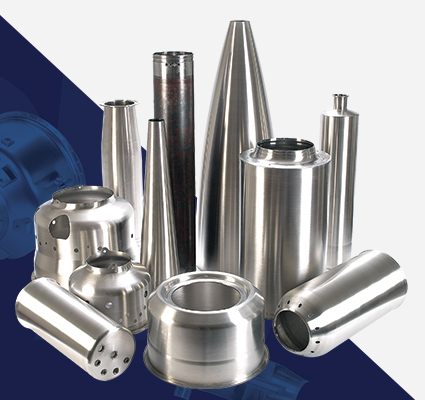Flowforming Offers Range of Benefits for Aerospace
Cold-extrusion metal forming process enables design flexibility, lower buy-to-fly ratio, and economical, lightweight parts
September 06, 2017
Traditionally, the design of metal components and assemblies for the aerospace sector has been widely dependent on several key factors, including the severity of the application, the materials selected, the required tolerance, and the overall weight, safety, and reliability of the final product. In the past decade, additional emphasis has been placed on cost and overall manufacturability to produce these complex components.
Although many processes are currently used in the formation of metal components for aerospace applications, one in particular—flowforming—is reported to offer “greater benefits across the spectrum,” according to PMF Industries, a contract metals fabricator based in Williamsport, Pennsylvania.
Flowforming offers a very high level of design flexibility and provides one of the best and most economical methods of producing high-precision, rotationally symmetrical, hollow parts. It is a cold-extrusion, metal-forming process that creates seamless, cylindrical, conical, and contoured near-net-shaped components from common forms of materials. Material is only displaced, not removed during the process.
Unlike metal spinning and other metal-forming processes that cannot precisely control material thickness, flowforming offers control by design of contours and wall thicknesses, capabilities that are highly beneficial when designing and manufacturing aerospace components. Also, because flowforming does not require elevating the temperature of the material for processing, the part is finished to near-net shape with limited or no distortion. Because the material is cold worked, subsequent heat treating, such as annealing or aging, may be desired.
Depending upon the manufacturing capabilities of the flowforming vendor, flowformed parts can be produced in lengths of up to 20 feet, with diameters ranging from 0.5 inch up to 48 inches. Because flowforming relies on 9944 state-of-the art, computer numerical control (CNC), it offers excellent repeatability and precise control of wall thickness, which typically can vary as little as ±0.005 inch. Flowforming is the only metal-forming process that allows design and production of thicker and thinner sections in any combination, almost anywhere along the length of the part, according to PMF. This allows engineers to have much more design flexibility and to use material only where it is required.
With its inherent design control and flexibility, flowforming is able to produce the very economical and lightweight parts that are ideal for use in aerospace applications. Aerospace components currently being flowformed include engine components (combustor cases and housings, liners, and fan cases), drive shafts, pressure accumulators, hydraulic cylinders, vibration dampening mounts, and accumulator housings for aircraft landing gear. Other aerospace components that are currently manufactured via flowforming are inner supports, static seals, combustor shrouds, and actuators for aircraft doors. Flowformed parts are reverse engineered by the flowform vendor. As a result, OEM engineers must give careful consideration to the finished part at the conception of the design.
Flowforming starts with a metal “preform” manufactured through deep drawing, forging, or machining. The “preforms” used in the process are engineered for each specific design or shape. As much as 85 percent of the preform (by weight) can be included in the final part, resulting in less waste, significant material savings, reduced inventory, less energy use, and dramatically lower costs than other metal-forming techniques. Also, because flowforming promotes one-piece construction of near-net-shape parts and assemblies, it generally requires few—if any—welds. This decreases the need for assembly and related mechanical, metallurgical, and materials testing. All of these economic advantages make flowforming’s “buy-to-fly ratio” exceptionally low, reports PMF.
The fact that flowforming requires few, if any, welds enables parts that traditionally have required multi-piece designs to be formed as single, seamless components. This permits the use of thinner, lighter materials—ideal for use in aerospace applications. If welding is required and thicker material is needed to accommodate the weld, flowforming can produce thicker wall dimensions where needed. Some of these materials and alloys, such as stainless steel, Inconel®, and titanium, are not easily formed through metal spinning or deep drawing, but possess excellent properties for flowforming.
Among the numerous materials that can be flowformed are a variety of steels, such as stainless steel, high strength low alloy steel (HSLA), maraging steel, alloy steel, and precipitated hardened stainless steel. In addition to titanium and Inconel, other materials that are well-suited for flowforming are Hastelloy®, brass, copper, aluminum, nickel, niobium, tantalum, and columbium.
Flowforming also can be combined with other metal-forming techniques to increase its versatility for aerospace applications. Flowformed components then can be sized, finished, machined, and flange-formed using secondary operations.
